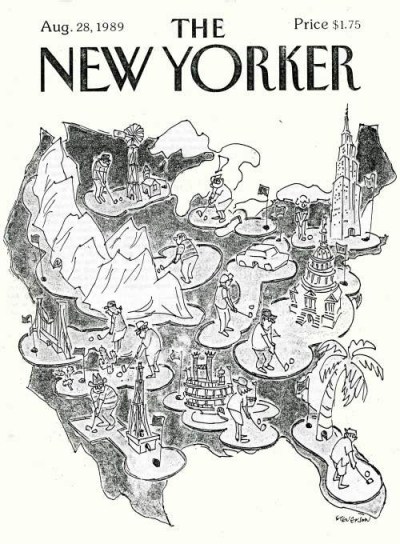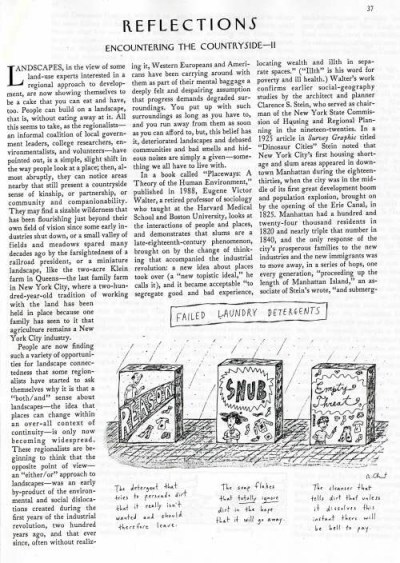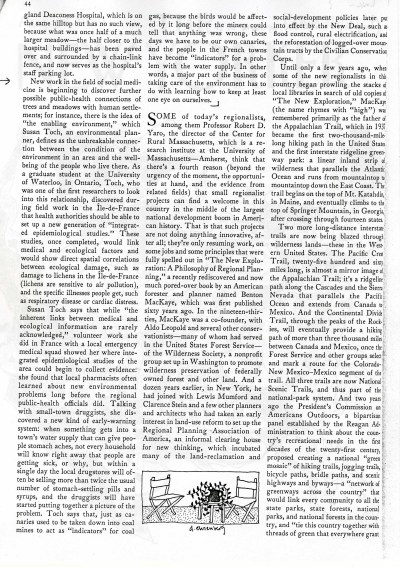Reflections
Encountering the Countryside -- II

LANDSCAPES, in the view of some land-use experts interested in a regional approach to development, are now showing themselves to be a cake that you can eat and have, too. People can build on a landscape, that is, without eating away at it. All this seems to take, as the regionalists -- an informal coalition of local government leaders, college researchers, environmentalists, and volunteers -- have pointed out, is a simple, slight shift in the way people look at a place; then, almost abruptly, they can notice areas nearby that still present a countryside sense of kinship, or partnership, or community and companionability. They may find a sizable wilderness that has been flourishing just beyond their own field of vision since some early industries shut down, or a small valley of fields and meadows spared many decades ago by the farsightedness of a railroad president, or a miniature landscape, like the two-acre Klein farm in Queens -- the last family farm in New York City, where a two-hundred-year-old tradition of working with the land has been held in place because one family has seen to it that agriculture remains a New York City industry. 
People are now finding such a variety of opportunities for landscape connectedness that some regionalists have started to ask themselves why it is that a "both/and" sense about landscapes -- the idea that places can change within an over-all context of continuity -- is only now becoming widespread. These regionalists are beginning to think that the opposite point of view -- an "either/or" approach to landscapes -- was an early by-product of the environmental and social dislocations created during the first years of the industrial revolution, two hundred years ago, and that ever since, often without realizing it, Western Europeans and Americans have been carrying around with them as part of their mental baggage a deeply felt and despairing assumption that progress demands degraded surroundings. You put up with such surroundings as long as you have to, and you run away from them as soon as you can afford to, but, this belief has it, deteriorated landscapes and debased communities and bad smells and hideous noises are simply a given -- something we all have to live with.
In a book called "Placeways: A Theory of the Human Environment," published in 1988, Eugene Victor Walter, a retired professor of sociology who taught at the Harvard Medical School and Boston University, looks at the interactions of people and places, and demonstrates that slums are a late-eighteenth-century phenomenon, brought on by the change of thinking that accompanied the industrial revolution: a new idea about places took over (a "new topistic ideal," he calls it), and it became acceptable "to segregate good and bad experience, locating wealth and illth in separate spaces." ("Illth" is his word for poverty and ill health.) Walter's work confirms earlier social-geography studies by the architect and planner Clarence S. Stein, who served as chairman of the New York State Commission of Housing and Regional Planning in the nineteen-twenties. In a 1925 article in Survey Graphic titled "Dinosaur Cities" Stein noted that New York City's first housing shortage and slum areas appeared in downtown Manhattan during the eighteen-thirties, when the city was in the middle of its first great development boom and population explosion, brought on by the opening of the Erie Canal, in 1825. Manhattan had a hundred and twenty-four thousand residents in 1820 and nearly triple that number in 1840, and the only response of the city's prosperous families to the new industries and the new immigrants was to move away, in a series of hops, one every generation, "proceeding up the length of Manhattan Island," an associate of Stein's wrote, "and submerg...
...gland Deaconess Hospital, which is on the same hilltop but has no such view, because what was once half of a much larger meadow -- the half closer to the hospital buildings -- has been paved over and surrounded by a chain-link fence, and now serves as the hospital's staff parking lot. 
New work in the field of social medicine is beginning to discover further possible public-health connections of trees and meadows with human settlements; for instance, there is the idea of "the enabling environment," which Susan Toch, an environmental planner, defines as the unbreakable connection between the condition of the environment in an area and the well-being of the people who live there. As a graduate student at the University of Waterloo, in Ontario, Toch, who was one of the first researchers to look into this relationship, discovered during field work in the Ile-de-France that health authorities should be able to set up a new generation of "integrated epidemiological studies." These studies, once completed, would link medical and ecological factors and would show direct spatial correlations between ecological damage, such as damage to lichens in the Ile-de-France (lichens are sensitive to air pollution), and the specific illnesses people get, such as respiratory disease or cardiac distress.
Susan Toch says that while "the inherent links between medical and ecological information are rarely acknowledged," volunteer work she did in France with a local emergency medical squad showed her where integrated epidemiological studies of the area could begin to collect evidence: she found that local pharmacists often learned about new environmental problems long before the regional public-health officials did. Talking with small-town druggists, she discovered a new kind of early-warning system: when something gets into a town's water supply that can give people stomach aches, not every household will know right away that people are getting sick, or why, but within a single day the local drugstores will often be selling more than twice the usual number of stomach-settling pills and syrups, and the druggists will have started putting together a picture of the problem. Toch says that, just as canaries used to be taken down into coal mines to act as "indicators" for coal gas, because the birds would be affected by it long before the miners could tell that anything was wrong, these days we have to be our own canaries, and the people in the French towns have become "indicators" for a problem with the water supply. In other words, a major part of the business of taking care of the environment has to do with learning how to keep at least one eye on ourselves.
SOME of today's regionalists, among them Professor Robert D. Yaro, the director of the Center for Rural Massachusetts, which is a research institute at the University of Massachusetts -- Amherst, think that there's a fourth reason (beyond the urgency of the moment, the opportunities at hand, and the evidence from related fields) that small regionalist projects can find a welcome in this country in the middle of the largest national development boom in American history. That is that such projects are not doing anything innovative, after all; they're only resuming work, on some jobs and some principles that were fully spelled out in "The New Exploration: A Philosophy of Regional Planning," a recently rediscovered and now much pored-over book by an American forester and planner named Benton MacKaye, which was first published sixty years ago. In the nineteen-thirties, MacKaye was a co-founder, with Aldo Leopold and several other conservationists -- many of whom had served in the United States Forest Service -- of the Wilderness Society, a nonprofit group set up in Washington to promote wilderness preservation of federally owned forest and other land. And a dozen years earlier, in New York, he had joined with Lewis Mumford and Clarence Stein and a few other planners and architects who had taken an early interest in land-use reform to set up the Regional Planning Association of America, an informal clearing house for new thinking, which incubated many of the land-reclamation and social-development policies later put into effect by the New Deal, such as flood control, rural electrification, and the reforestation of logged-over mountain tracts by the Civilian Conservation Corps.
Until only a few years ago, when some of the new regionalists in this country began prowling the stacks of local libraries in search of old copies of "The New Exploration," MacKaye (the name rhymes with "high") was remembered primarily as the father of the Appalachian Trail, which in 1937 became the first two-thousand-mile-long hiking path in the United States and the first interstate ridgeline green-way park: a linear inland strip of, wilderness that parallels the Atlantic Ocean and runs from mountaintop to mountaintop down the East Coast. The trail begins on the top of Mt. Katahdin, in Maine, and eventually climbs to the top of Springer Mountain, in Georgia, after crossing through fourteen states.
Two more long-distance interstate trails are now being blazed through wilderness lands -- these in the Western United States. The Pacific Crest Trail, twenty-five hundred and sixty, miles long, is almost a mirror image of, the Appalachian Trail; it's a ridgeline path along the Cascades and the Sierra Nevada that parallels the Pacific-Ocean and extends from Canada to Mexico. And the Continental Divide Trail, through the peaks of the Rockies, will eventually provide a hiking path of more than three thousand miles between Canada and Mexico, once the: Forest Service and other groups select and mark a route for the Colorado-New Mexico-Mexico segment of the trail. All three trails are now National Scenic Trails, and thus part of the: national-park system. And two years; ago the President's Commission on Americans Outdoors, a bipartisan I panel established by the Reagan Administration to think about the country's recreational needs in the first decades of the twenty-first century, proposed creating a national "green mosaic" of hiking trails, jogging trails, bicycle paths, bridle paths, and scenic highways and byways -- a "network of greenways across the country" that would link every community to all the state parks, state forests, national parks, and national forests in the country, and "tie this country together with threads of green that everywhere grant...
|
